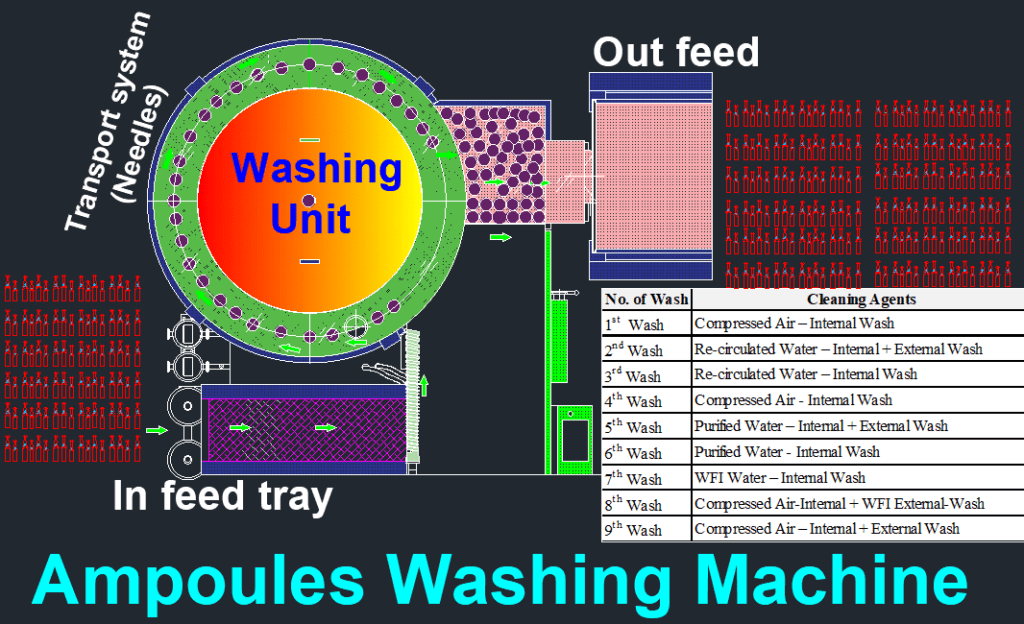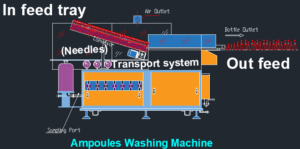The Ampoule/Vial Washing Machine is the equipment used to clean the primary packaging material like Ampoules or vials in Injectable or vaccine manufacturing plants. In this blog, we briefly provide a description of the working principles, uses, procedures, processes, and validation. Operation of this washing machine is like that, Ampoules/vials shall be loaded manually to the in-feed bay by SS trays and transferred to the washing machine in a group by the transport system. The Ampoule/Vial Washing Machine has a washing unit that shall wash the ampoule or Vial from the inside as well as from the outside.
The washing cycle shall include washing with filtered re-circulated WFI, Internal blow with compressed air then washing with purified water followed by a second blow of compressed air, and be finally washed with WFI and drying with 0.2 microns filtered compressed air.
Ampoule washing machine shall be provided with a minimum of six washing stations. The washed Vials/Ampoules shall be transferred to the tunnel by the conveying system under LAF.

Equipment Description :
| S. No. | Description | Purpose |
| 1 | Infeed tray | Feeding the Ampoules for the pre-washing. The Ampoules are kept manually on the bay by trays. |
| 2 | Transport system (needles) | Transporting the prewashed Ampoules to the needles for washing. |
| 3 | Washing unit | Washing the Ampoules with re-circulated WFI, Purified water, and Fresh WFI. |
| 4 | Outfeed | Washed Ampoules collection/ in the feed of washed ampoules into the Tunnel. |
The followings are the Functional Specification of the Ampoule/Vial Washing Machine:
- Bottle/Vial/Ampoule Size: 1 – 20ml (E.g.)
- Capability: Bottle/Vial/Ampoule per hour.
- Bottle Washing Quality Rate: (E.g.) >99%.
- Bottle Break Rate: (E.g.) <0.3%.
- Water Consumption: (E.g.) 0.4-0.6 m3/h in 0.2-0.3 mpa.
- Gas Consumption: (E.g.) 40-50 m3/h in 0.25-0.35 mpa.
- Outside Dimension: (E.g.) 2000*2000*1200 mm.
- Machine Weight: (E.g.) 2,000 kg.
- Power Supply: (E.g.) 420 V/ 50 Hz.
- Power Consumer: (E.g.) 15 kw.
Types of Ampoule/Vial Washing Machine :
1. Rotary washing machines: Rotary washing machines have varied outputs of vials and work in rotary motion.
2. Linear washing machine: Linear washing machine’s work is to automatically load arrangement facilities of vials onto SS wire mesh conveyor through a feed conveyor and vials are fed into pockets directly.
Working Principle of Ampoule/Vial Washing Machine :
The Ampoule/Vial Washing Machine works on the principle of jet washing the individual vials or ampoules in an inverted position by a series of jets.
The vials are loaded on the loading station by placing a box or tray of vials on it. The complete layer of the vials is pushed to the in-feed conveyor then the vials go to the machine’s platform.
Where an in-feed lifter carries the vials into the pockets. After vials reach into pockets, the pocket channel runs to the backside.
During this process, the pocket channel stays, the washing nozzle manifold raises up and a nozzle enters into the mouth of each individual vial.
A solenoid valve of the water and air lines is activated and a jet of air/water hits the inside and outside of the vial to thoroughly clean it.
Washing will occur in the following sequence in the Ampoule/Vial Washing Machine.
| Number of Wash | Cleaning Agent |
|---|---|
| 1st Wash | Compressed Air – Internal Wash |
| 2nd Wash | Re-circulated Water – Internal + External Wash |
| 3rd Wash | Re-circulated Water – Internal Wash |
| 4th Wash | Compressed Air – Internal Wash |
| 5th Wash | Purified Water – Internal + External Wash |
| 6th Wash | Purified Water – Internal Wash |
| 7th Wash | WFI Water – Internal Wash |
| 8th Wash | Compressed Air-Internal + WFI External-Wash |
| 9th Wash | Compressed Air – Internal + External Wash |

Major Components of the Ampoule/Vial Washing Machine :
- The Vial/Ampoule entry Conveyer: this is made of two sections of net belt structure to ensure that the Bottle/Vial/Ampoule has enough thrust. So that the lead screw does not lack the Bottle/Vial/Ampoule and does not pour the bottle, so to ensure the stability of the bottle. (Net belt specific width).
- Lift device: This is made up of a wheel and camshaft. The sliding block is embedded in T type of slot around the wheel. The support plate is set on the sliding block. Also, Pulley is set on the camshaft of the sliding board. Pulley turns the sliding board moves up and down. It makes the bottles Bottle/Vial/Ampoule transport accurately.
- Oil leakage prevention mechanism: This is arranged on the extending rod of the mechanical hand and the large market to ensure that the lubricating oil does not pollute the sink.
- The utility model is provided with a needle anti-shake device, which improves the accuracy of the injection needle entering the bottle and reduces the broken bottle and the broken needle phenomenon in the high-speed operation of the bottle.
- The clamps and its mechanical arm: This will use non-toxic pollution-free polyamine material. It has both a damping effect and good strength, to protect the bottle from breakage, and enhance the serving life as well.
- The inner surface of the cleaning process has been completed a total of three times for flushing and the outer wall of a bottle of water and gas washing. A spray needle is fixed corresponding to a cleaning medium without cross-contamination; the spray needle is inserted into the bottle for tracking and cleaning; the bottle mouth cone positioning guiding device is adopted to reduce the damage to the bottle by spraying, and the cleaning effect is good Ampoule/Vial Washing Machine.
- Filters and their Assembly:
- Recycled water, 3um polyethersulfone filters,
- Water for injection, 0.22um polyethersulfone filter,
- Compressed air, 0.22um PTFE filter.
The washer will apply one-time WFI washing and two times recycled water washing. It uses the needle to track and insert, and the PLC controls the solenoid valve to intermittently spray water and jet to achieve effective cleaning under the energy-saving state.
At the same time, the WFI water after cleaning will be used as circulating/recycled water after passing through the return water tank, the sanitary water pump, and then filtering through the filters.

Ampoule/Vial Washing Machine :
- Main Drive Motor Base of the machine.
- The pump Motor Flange is mounted, within the Piping Zone.
- Filter Housing Rear end of the machine within the Piping Zone.
- Pressure Gauges and Pressure Switches on the Front side of the machine, on top of the piping zone.
- Machine Hand Wheel Front side of the machine.
- Valves On the respective pipelines.
- Solenoids On the respective pipelines.
- The drum is Centrally located in the working zone.
- Needles On the Drum.
- Feed Hopper Front side of the machine.
- Discharging the Hopper Rear end of the machine.
- Drum Guard In the working zone covering the Drum.
- Water Immersion Heaters Within the water bath, inserted from the Front Side Bottom.
- HF Generation Unit Within the bath.
- RTD PT-100 Bottom Front side of the machine.
- Feed Screw Within the working zone moving from bottom to top.
- Feed Screw and star wheel Within the working zone, just after the BDC of the In-Feed Hopper.
- External and internal Spray Just near the BDC of the In-Feed Hopper. The spray is from the top.
- Swing-out unit At the rear end of the machine, where the Vials are discharged.
Certification & Documentations Ampoule/Vial Washing Machine
- GA Drawing & P&ID, Complete set of Top, Side & Elevation view.
- Ladder logic drawings.
- Motor certificates along with a flameproof certificate.
- MOC certificates of all contact & major non-contact parts including gaskets.
- Certificate of filter bag, pressure test certificate, or each component certificate.
- Complete set of DQ, and IQ Documents.
- All documents are as per URS
Manufacturers (OEMs) of the Ampoule/Vial Washing Machine:
World wide there are many manufacturers are there for the Ampoule/Vial Washing Machines, Some of the well-known manufacturers are:
- 1.Truking Technology Ltd.
- 2. Snowbell Machines Pvt. Ltd.
- 3. Groninger & co. gmbh
- 4. NKP Pharma Pvt. Ltd.
- 5. Ambica Engineering Works
- 6. United Engineering
- 7. IMA PG Industries
- 8. Romaco Pharmatechnik GmbH
- 9. Bosch Packaging Technology
- 10. Accutek Packaging Equipment Companies, Inc.
- 11. Harsiddh Engineering Co
FAQ regarding Ampoule/Vial Washing Machine:
What is ampoule washing machine?
Answer: The machine known as an ampoule washer is made specifically to wash ampoules with the least amount of touch to any machine components. These machines are equipped with a Gripper system that is specially intended to hold and support the ampoules from their necks while inverting them throughout the washing process and even release them once the washing is over. Following washing, they are discharged via a feed worm system, which is an outfeed system. These feed worm systems are kept upright to guarantee the successful washing of ampoules.
How ampoules are washed?
Answer: The most effective approach to cleaning an ampoule is to use a high-pressure jet spray both inside and outside the bottle. If you use WFI water to spray the washing, it will work better. When cleaning duties are completed, minute bacteria, contamination-causing particles, contaminated substances, and bacterial toxin residue are all eliminated.
What is vial washing machine?
Answer: vial washing equipment designed to clean the internal and external surfaces of vials. Vials are kept in pockets while being cleaned. It features 2 to 16 washing stations, each with 3 to 5 internal water washes using recycled water, purified water, and WFI, as well as three to five air washes. One water and air wash are used to clean the exterior surfaces.
How many cycles are there in vial washing machine?
Answer: Followings are the washing cycles for vial washing:
1st Wash Compressed Air – Internal Wash
2nd Wash Re-circulated Water – Internal + External Wash
3rd Wash Re-circulated Water – Internal Wash
4th Wash Compressed Air – Internal Wash
5th Wash Purified Water – Internal + External Wash
6th Wash Purified Water – Internal Wash
7th Wash WFI Water – Internal Wash
8th Wash Compressed Air-Internal + WFI External-Wash
9th Wash Compressed Air – Internal + External Wash
For more technical details Ampoule/Vial Washing Machine, best equipment vendor comparison, or any type of documentation. (SOP,DQ,IQ,OQ,PQ etc.) Please get in touch with us at: admin@flairpharma.com

Thanks for Information